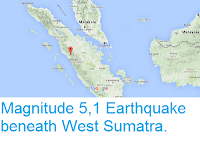The United States Geological Survey
recorded a Magnitude 5.7 Earthquake at a depth of 10 km, about 18 km to the northeast of the town of Kabanjahe in North Sumatra Province, Indonesia slightly after 7.40 pm Western Indonesian Time (slightly after 12.40 pm GMT) on Monday 16 January 2017. There are no reports of any damage or casualties associated with this quake, but people have reported feeling it across North Sumatra and Peninsula Malaysia.
The approximate location of the 16 January 2017 Earthquake. USGS.
The
Indo-Australian Plate, which underlies the Indian Ocean to the west of
Sumatra, is being subducted beneath the Sunda Plate, a breakaway part of
the Eurasian Plate which underlies Sumatra and neighbouring Java, along
the Sunda Trench, passing under Sumatra, where friction between the two
plates can cause Earthquakes. As the Indo-Australian Plate sinks further
into the Earth it is partially melted and some of the melted material
rises through the overlying Sunda Plate as magma, fuelling the volcanoes
of Sumatra.
The Subduction zone beneath Sumatra. NASA/Earth Observatory.
This
does not happen at a 90° angle, as occurs in the subduction zones along
the western margins of North and South America, but at a steeply
oblique angle. This means that as well as the subduction of the
Indo-Australian plate beneath the Sunda, the two plates are also moving
past one-another. This causes rifting within the plates, as parts of
each plate become stuck to the other, and are dragged along in the
opposing plate's direction. The most obvious example of this is the
Sumatran Fault, which runs the length of Sumatra, with the two halves of
the island moving independently of one-another. This fault is the cause
of most of the quakes on the island, and most of the island's volcanoes
lie on it.
The movement of the tectonic plates around Sumatra. NASA/Earth Observatory.
Witness
accounts of Earthquakes can help geologists to understand these events,
and the structures that cause them. The international non-profit
organisation Earthquake Report is interested in hearing from people who may have felt this event; if you felt this quake then you can report it to Earthquake Report here.
See also...









